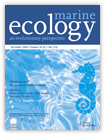Spatial Variation in the Structure of Kelp Forest Communities Along a Wave Exposure Gradient
Abstract
Abstract. Four sites were sampled in kelp (Macrocysiis pyrifera) forests occupying rocky bottom habitats along a wave exposure gradient in central California. Consistent betwecn-site differences were found in the three major structural elements - the surface canopy, the undcrstory assemblage, and the ground cover/turf assemblage - of kelp forest communities. Macrocysiis pyrifera was found at all four sites. Nereucyslis tuelkeana only at the most exposed site. The understory kelps Laminaria setchellii and Pterygopltora californica were also characteristic of exposed sites. Articulated coralline algae were more abundant at exposed sites than protected, while fleshy red algae showed the opposite pattern. All four study sites were located along 8.5 km of coastline, and thus were assumed to have available to them the same species pool for colonization. The substrate composition was the same and the amount of unconsolidated substrate was similar at all four sites. We suggest that exposure to wave-generated water motion, through its influence on the surface canopy and therefore on the amount of light reaching the bottom, is responsible for these between-site differences.




